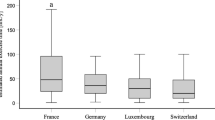Abstract
Objective
Surgical training programs nationwide are struggling with the integration of simulation training into their curriculum given the constraints of the 80-h work week. We examine the effectiveness of voluntary training in a simulation lab as part of the surgical curriculum.
Methods
The ProMISTM simulator was introduced into the general surgery residency at Boston University Medical Center. All categorical residents (28) and non-categorical residents (23) were offered a 2-h training session and curriculum review. After the introductory session, time spent in the lab was encouraged, but voluntary. Use of the simulator was tracked for all residents. Participation in the simulation curriculum was defined as three or more uses of the simulator. After 3 months, all residents completed a survey regarding the simulation lab and their simulator usage.
Results
Twenty-six (93%) categorical residents and three (6%) non-categorical residents completed the introductory simulator training session. Over a 3 month period, use of the simulator at least once was 31% among all eligible residents; 80% of postgraduate year (PGY)1, 40% of PGY2, 60% of PGY3, and 0% of PGY4 and PGY5. Four residents (14%) participated in the simulation curriculum. Overall, 70% of simulator usage was during working hours, and 30% was completed post-call or when the resident was off duty. Most residents agreed that the simulator was easy to use and that its use improved their operative skills, but they did not think it was a good substitute for actual operative experience. Reported reasons for not using the simulator included off-site rotation (44%), no time (30%), and no interest (11%).
Conclusions
Voluntary use of a surgical simulation lab leads to minimal participation in a training curriculum. Participation should be mandatory if it is to be an effective part of a residency curriculum.
Similar content being viewed by others
References
Acceditation Council for Graduate Medical Education (ACGME) website at http://www.acgme.org, Common Program Requirements (PDF), editorial revision February 2004, p. 7
DeMaria EJ, McBride CL, Broderick TJ, Kaplan BJ (2005) Night call does not impair learning of laparoscopic skills. Surg Innov 12: 145–149
Fried GM, Feldman LS, Vassiliou MC, Fraser SA, Stanbridge D, Ghitulescu G, Andrew CG (2004) Proving the value of simulation in laparoscopic surgery. Ann Surg 240: 518–525
Gallagher AG, Smith CD, Bowers SP, Seymour NE, Pearson A, McNatt S, Hananel D, Satava RM (2003) Psychomotor skills assessment in practicing surgeons experienced in performing advanced laparoscopic procedures. J Am Coll Surg 197: 479–488
Gallagher AG, Ritter EM, Champion H, Higgins G, Fried MP, Moses G, Smith CD, Satava RM (2005) Virtual reality simulation for the operating room: proficiency-based training as a paradigm shift in surgical skills training. Ann Surg 241: 364–372
Grantcharov TP, Kristiansen VB, Bendix J, Bardram L, Rosenberg J, Funch-Jensen P (2004) Randomized clinical trial of virtual reality simulation for laparoscopic skills training. Br J Surg 91: 146–150
Hammond L, Ketchum J, Schwartz BF (2005) Accreditation council on graduate medical education technical skills competency compliance: urologic surgical skills. J Am Coll Surg 201: 454–457
Jakubowicz DM, Price EM, Glassman HJ, Gallagher AJ, Mandava N, Ralph WP, Fried MP (2005) Effects of a twenty-four hour call period on resident performance during simulated endoscopic sinus surgery in an accreditation council for graduate medical education-compliant training program. Laryngoscope 115: 143–146
Korndorffer JR Jr, Dunne JB, Sierra R, Stefanidis D, Touchard CL, Scott DJ (2005) Simulator training for laparoscopic suturing using performance goals translates to the operating room. J Am Coll Surg 201: 23–29
Scott DJ, Bergen PC, Rege RV, Laycock R, Tesfay ST, Valentine RJ, Euhus DM, Jeyarajah DR, Thompson WM, Jones DB (2000) Laparoscopic training on bench models: better and more cost effective than operating room experience? J Am Coll Surg 191: 272–283
Seymour NE, Gallagher AG, Roman SA, O’Brien MK, Bansal VK, Andersen DK, Satava RM (2002) Virtual reality training improves operating room performance: results of a randomized, double-blinded study. Ann Surg 236: 458–463
Van Sickle KR, McClusky DA 3rd, Gallagher AG, Smith CD (2005) Construct validation of the ProMIS simulator using a novel laparoscopic suturing task. Surg Endosc 19: 1227–1231
Acknowledgments
This study was supported in part by Ethicon Endo-surgery, Inc., a division of Johnson & Johnson Company.
Author information
Authors and Affiliations
Corresponding author
Additional information
This work was presented in a Poster Session at the SAGES Conference on April 28, 2006
Rights and permissions
About this article
Cite this article
Chang, L., Petros, J., Hess, D.T. et al. Integrating simulation into a surgical residency program . Surg Endosc 21, 418–421 (2007). https://doi.org/10.1007/s00464-006-9051-5
Received:
Revised:
Accepted:
Published:
Issue Date:
DOI: https://doi.org/10.1007/s00464-006-9051-5




